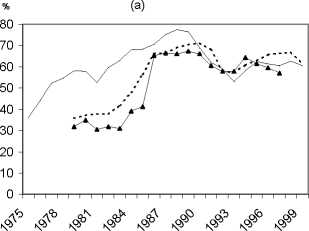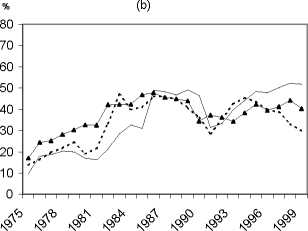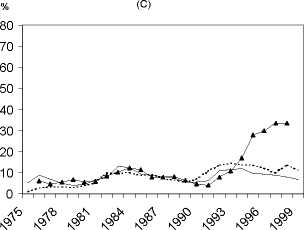

----Belgium —*—Ireland ......Italy ----Germany —*—France ......UK
Source: OECD

---USA —*— Sweden .........Canada
Figure 1: Development of Long-Term Unemployment on Total Unemployment for
Groups of Countries.
levels of capital intensities is evaluated in a growth-matching-model with a heteroge-
neous unemployment pool, consisting of short-term and long-term unemployed, and
with endogenously determined skill-depreciation of the long-term jobless workers.
It will be shown that, due to a capitalization effect and a qualification-mismatch
effect, increasing technological progress has adverse implications on long-term un-
employment in innovation economies which are characterized by high steady-state
levels of capital intensities. Furthermore, for imitation economies with low steady-
state capital intensities technological progress can be favorable or unfavorable for
long-term unemployment depending on whether the creative destruction effect or
the capitalization effect dominates.
Before the model is developed in section 3, a short review of the literature dis-
cussing the relationship between technical progress and unemployment is given in
the following section. Section 4 analyses the steady-state solution and the stability
of the model and, thereafter, economic implications are shown in section 5. Section
6 concludes the discussion.
More intriguing information
1. The value-added of primary schools: what is it really measuring?2. Short Term Memory May Be the Depletion of the Readily Releasable Pool of Presynaptic Neurotransmitter Vesicles
3. The name is absent
4. The name is absent
5. The Role of Trait Emotional Intelligence (El) in the Workplace.
6. Industrial Cores and Peripheries in Brazil
7. Spatial Aggregation and Weather Risk Management
8. Who runs the IFIs?
9. Partner Selection Criteria in Strategic Alliances When to Ally with Weak Partners
10. The name is absent